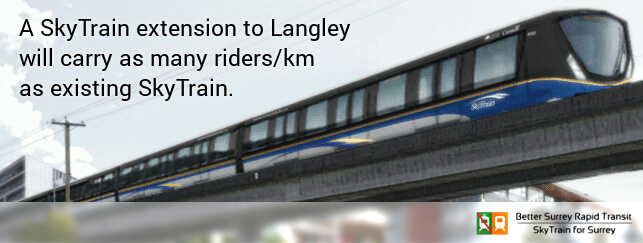IMMEDIATE RELEASE – Surrey, BC
The City of Surrey has jeopardized its own “Plan B” for Light Rail Transit by neglecting to account for the financial effects of poor ridership and a fare revenue short-fall.
A previous joint study commissioned by TransLink and the Province found that the proposed LRT will require an operating subsidy of $22 million per year on opening day, rising to $28 million per year by 2041. This is on top of the $60 million per year for capital financing that Mayor Linda Hepner declared to the Globe and Mail, plus the long-term costs of repaying private capital investment.
Accounting for this short-fall Surrey taxpayers would be on the hook for nearly $100 million per year to finance LRT as a public-private partnership (P3).
This is because a street-level LRT attracts less ridership, owing to slower and less reliable service. A SkyTrain extension would attract significantly higher ridership, generating enough fare revenue to cover its own costs and offering a superior transit alternative for Surrey residents.
Better Surrey Rapid Transit previously noted that the city’s new LRT study ignored transportation aspects and sidestepped issues that our campaign and others had raised. Commuters will save only 1 minute with the proposed Phase I LRT, versus the present commute on the 96 B-Line.
Better Surrey Rapid Transit (SkyTrain for Surrey) is the citizens’ campaign against ground-level LRT in Surrey. Our campaign manager is Daryl Dela Cruz, a popular regional transit issues voice whose research has been cited by transportation professionals.
***
For additional info, contact: Daryl Dela Cruz, Campaign Manager – Better Surrey Rapid Transit.
Email us at: [email protected]
###
Attachment: A P3 doesn’t work for LRT in Surrey
The Canada Line P3 was a successful P3 because its ridership and fare revenue exceeded projections.
The private partner’s capital investment in the project is returned as a profit through the performance payments made during operation. If fare revenue from ridership meets or exceeds the costs, financing proceeds as planned and excess operating revenue is returned to the taxpayer. If the fare revenue does not exceed the costs, that represents significant additional costs to taxpayers to subsidize operations.
The Surrey LRT system will not recover its operating costs. Under a Canada Line Design-Build-Finance-Maintain-Operate P3 model, it will cost the city nearly $100 million per year to finance LRT.
This is because the fare revenue projected over 30 years creates a $720 million shortfall over the 30-year lifecycle. It will require a subsidy of $22 million per year on opening day ($28 million per year by 2041) to operate the LRT.1 This is on top of the $60 million per year for capital financing that Mayor Linda Hepner declared to the Globe and Mail, plus additional costs added to concession payments so that the private operator makes a profit. The annual cost will be nearly $100 million, increasing over time.

Above: Financial details for Surrey Rapid Transit, reported in the TransLink/MOTI joint study
The Canada Line, which carries 122,000 daily boardings2, required 100,000 (5200 passenger boardings per km) to cover its annual operating costs.3 Surrey’s LRT will carry only 2970 riders/km on opening day.4
If SkyTrain is extended down Fraser Hwy. to Langley, it will carry 5443 riders per km on opening day.4 This is comparable to SkyTrain’s present system-wide average of 5693 riders per km.5

SkyTrain would offer faster, safer, and more reliable service – which would attract more ridership, generate more fare revenue and as a result cost only $6 million per year to subsidize operations.6 This would be eliminated entirely with concurrent optimization of local bus routes.7
SkyTrain would generate 2x as many new transit trips and has a positive benefit/cost ratio of 1.45:1, a far better business case for any funding. The proposed LRT has a poor benefit/cost ratio of just 0.69:1.
A SkyTrain extension is the only viable option for rail rapid transit in Surrey.
Footnotes
According to data from the 2012 TransLink/MOTI joint study Surrey Rapid Transit Alternatives Analysis (SRTAA) Phase 2 Evaluation Available on our website at [LINK HERE]
1. SRTAA PAGE 369; Undiscounted value; measured over 30 years; costs increase to 2041 levels in 2041
2. ProTransBC (operator) website – http://www.protransbc.com/service-performance/
3. TransLink media release – Addressing Canada Line capacity questions
4. See SRTAA PAGE 301 for ridership estimates (divided by track lengths listed on SRTAA P. 347)
5. Based on APTA ridership data from Q4 2014
6. See attached graphic, or SRTAA PAGE 369
7. Suggested on SRTAA PAGE 536: “For RRT 1A, savings of $170 million” (Discounted net present value)
Below: this advertisement keeps our website up and running. Thank you for your understanding.

